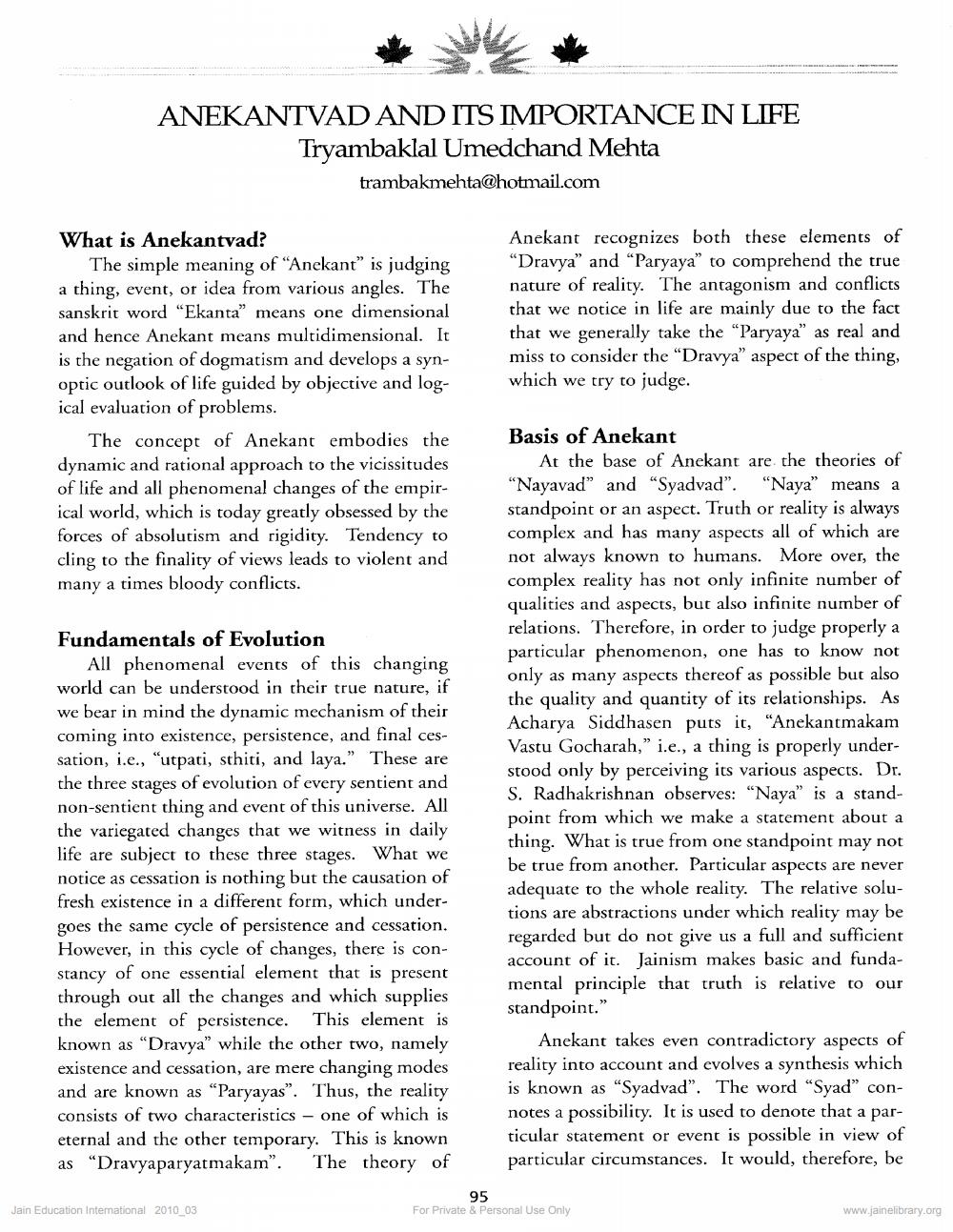________________
ANEKANTVAD AND ITS IMPORTANCE IN LIFE
Tryambaklal Umedchand Mehta
[email protected]
Anekant recognizes both these elements of "Dravya” and “Paryaya” to comprehend the true nature of reality. The antagonism and conflicts that we notice in life are mainly due to the fact that we generally take the “Paryaya” as real and miss to consider the "Dravya” aspect of the thing, which we try to judge.
What is Anekantvad?
The simple meaning of "Anekant” is judging a thing, event, or idea from various angles. The sanskrit word “Ekanta" means one dimensional and hence Anekant means multidimensional. It is the negation of dogmatism and develops a synoptic outlook of life guided by objective and logical evaluation of problems.
The concept of Anekant embodies the dynamic and rational approach to the vicissitudes of life and all phenomenal changes of the empirical world, which is today greatly obsessed by the forces of absolutism and rigidity. Tendency to cling to the finality of views leads to violent and many a times bloody conflicts.
Fundamentals of Evolution
All phenomenal events of this changing world can be understood in their true nature, if we bear in mind the dynamic mechanism of their coming into existence, persistence, and final cessation, i.e., “utpati, sthiti, and laya.” These are the three stages of evolution of every sentient and non-sentient thing and event of this universe. All the variegated changes that we witness in daily life are subject to these three stages. What we notice as cessation is nothing but the causation of fresh existence in a different form, which undergoes the same cycle of persistence and cessation. However, in this cycle of changes, there is constancy of one essential element that is present through out all the changes and which supplies the element of persistence. This element is known as "Dravya" while the other two, namely existence and cessation, are mere changing modes and are known as “Paryayas". Thus, the reality consists of two characteristics - one of which is eternal and the other temporary. This is known as “Dravyaparyatmakam". The theory of
Basis of Anekant
At the base of Anekant are the theories of "Nayavad" and "Syadvad". "Naya" means a standpoint or an aspect. Truth or reality is always complex and has many aspects all of which are not always known to humans. More over, the complex reality has not only infinite number of qualities and aspects, but also infinite number of relations. Therefore, in order to judge properly a particular phenomenon, one has to know not only as many aspects thereof as possible but also the quality and quantity of its relationships. As Acharya Siddhasen puts it, "Anekantmakam Vastu Gocharah,” i.e., a thing is properly understood only by perceiving its various aspects. Dr. S. Radhakrishnan observes: “Naya" is a standpoint from which we make a statement about a thing. What is true from one standpoint may not be true from another. Particular aspects are never adequate to the whole reality. The relative solutions are abstractions under which reality may be regarded but do not give us a full and sufficient account of it. Jainism makes basic and fundamental principle that truth is relative to our standpoint."
Anekant takes even contradictory aspects of reality into account and evolves a synthesis which is known as "Syadvad". The word "Syad" connotes a possibility. It is used to denote that a particular statement or event is possible in view of particular circumstances. It would, therefore, be
Jain Education Intemational 2010_03
95 For Private & Personal Use Only
www.jainelibrary.org




